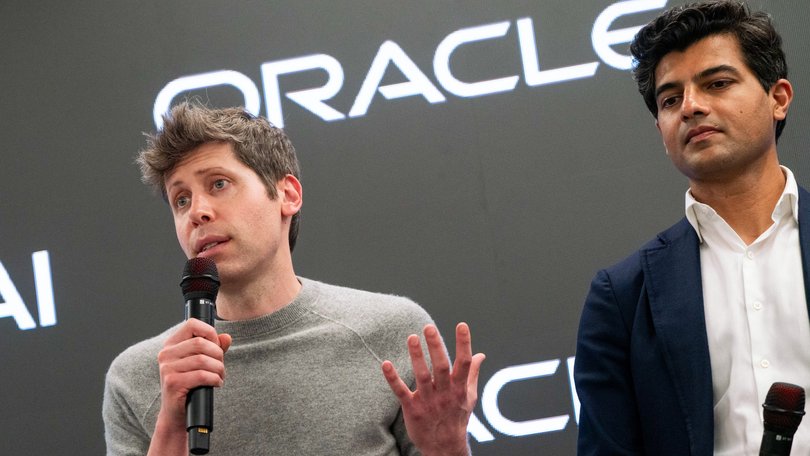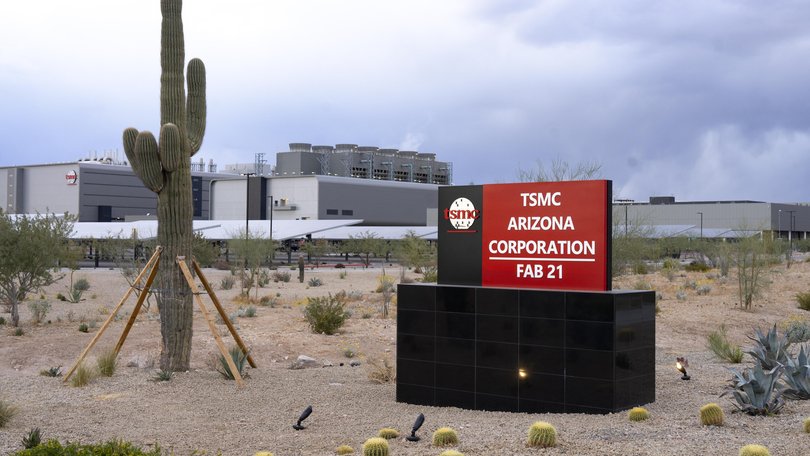ECONOMIST: Much of AI boom depends on one company — and one man, Sam Altman. What if OpenAI went belly-up?

Look around the world of artificial intelligence and OpenAI is everywhere. In early September ChatGPT’s creator reportedly struck a deal to buy perhaps $US10 billion ($15 billion)-worth of custom AI chips from Broadcom.
A fortnight later the start-up revealed that Nvidia, Broadcom’s larger rival, would invest up to $US100 billion ($150 billion) in it over several years while selling it graphics-processing units (GPUs) worth that amount.
On October 6 OpenAI announced a deal with AMD, a third chipmaker, of similar size and circularity. This time it is OpenAI that may take a stake in AMD, which would sell it silicon worth an estimated $US90 billion or so between 2026 and 2030.
Sign up to The Nightly's newsletters.
Get the first look at the digital newspaper, curated daily stories and breaking headlines delivered to your inbox.
By continuing you agree to our Terms and Privacy Policy.This is the past month alone — and just chips. In that time OpenAI also agreed to buy $US300 billion in computing power from Oracle, a data-centre giant; plugged popular apps such as Booking.com, Spotify and Zillow into ChatGPT, letting users search for hotels, songs and flats via the chatbot; and gave Hollywood a jump scare with Sora 2, its new video-generating app.
Along the way it became the world’s most valuable start-up, rocketing past SpaceX after raising $US6.6 billion at a price tag of $US500 billion.
OpenAI may be a way off attaining its goal of creating superintelligence. But Sam Altman, its boss, already wields God-like power over markets. The Broadcom, Nvidia and AMD announcements added almost $US200 billion, $US160 billion and over $US60 billion — or 13 per cent, 4 per cent and 24 per cent — to the respective chipmakers’ market values. Oracle’s shot up by more than $US250 billion when its OpenAI contract came to light, climbing above $US900 billion.

The ubiquity of Mr Altman and his start-up, plus its convoluted links to other AI firms, is raising eyebrows.
An awful lot seems to hinge on a firm forecast to lose $US10 billion this year on revenues of little more than that amount. DA Davidson, a broker, calls OpenAI “the biggest case yet of Silicon Valley’s vaunted ‘fake it ’till you make it’ ethos”.
Only Nvidia is more central to the AI boom, going by the scale of the industry’s incestuous relationships. To understand the model-maker’s centrality to the whole AI enterprise, consider a thought experiment. What if OpenAI went bust?
Such an outcome is unlikely but not inconceivable. The firm will probably not turn a profit for years. Lawyers predict that Sora could provoke a flood of costly lawsuits from copyright owners whose intellectual properties, from SpongeBob SquarePants to Ronald McDonald, are already popping up in user-generated clips.
Mr Altman would not be the first boss whose knack for getting investors to part with cash looked preternatural until it didn’t.
Even if it does not come to that, a thought experiment to test how the AI edifice holds up if you remove the keystone can be instructive; it lets you evaluate what you might call key-firm risk.
The immediate casualties of ClosedAI would be the shareholders. Since its founding ten years ago the start-up has raised a total of $US35 billion from 149 investors.
Most would smart but survive; 45 of them also back Anthropic, OpenAI’s model-making rival, according to data from PitchBook, a deal-tracker. Mr Altman’s 4500 brainy employees would see the value of their stock options go to zero but find other work without breaking a sweat.
The impact on OpenAI’s counterparties would be more mixed. Oracle’s $US300 billion in contractual commitments from OpenAI would evaporate — so would the related shareholder gains. AMD, which certain analysts now think will be supplying Oracle with most of the GPUs required to fulfil the contract, may also see sales drop. But the hit to its owners would be alleviated by OpenAI not being around to exercise its warrants and thus dilute their stakes.
For other chipmakers the result may be close to a wash. Companies other than OpenAI are lining up to get their hands on AI chips. Nvidia’s three largest customers, which accounted for 34 per cent of sales last year, are believed to be Microsoft, Amazon and Meta. Broadcom sells lots of chips to Alphabet, Google’s $US3 trillion parent company and OpenAI’s other big competitor in model-building.
The problem for the chip firms is not lack of demand but constrained supply. Nvidia and Broadcom, as well as AMD and other designers of AI processors such as Marvell, which makes them for Amazon’s cloud, outsource virtually all their manufacturing to TSMC.
The Taiwanese firm is raising capital spending by 15 per cent a year. Between the last quarter of 2022, when ChatGPT began turning heads, and the second quarter of this year its fixed assets expanded by 30 per cent.
That looks like a lot — until you realise that the combined quarterly sales of Nvidia, Broadcom and AMD more than tripled in that period.

Alt-ernative history
TSMC’s share price thus shrugs off most OpenAI news. Other companies suffer when Mr Altman presents his latest partnership. Four of OpenAI’s six big deal announcements this year were followed by a total combined net gain of $US1.7 trillion among the 49 big companies in Bloomberg’s broad AI index plus Intel, Samsung and SoftBank (whose fate is also tied to the technology). However, the gains for most concealed losses for some — to the tune of $US435 billion in gross terms if you add them all up.
Some of these may be unrelated to OpenAI. Of those that were related, some might owe to the losers being seen as missing out on Mr Altman’s business: on October 6, for example, Nvidia’s market value dipped by nearly as much in dollar terms as AMD’s rose.
But sometimes what was good for OpenAI was bad for others: when Oracle soared by $US250 billion a month ago, Alphabet and Meta, which compete with OpenAI more directly, slumped by $US40 billion between them. So what is bad for it may be good for them.
In all, then, key-firm risk looks manageable.
Unless, that is, OpenAI were to fail not as a result of its own shortcomings but because the technology itself proved less transformational than promised. But that is another thought experiment.
Originally published as What if OpenAI went belly-up?
